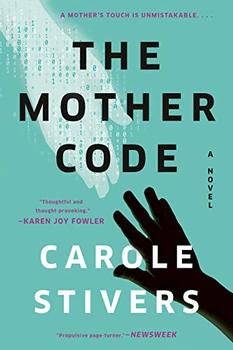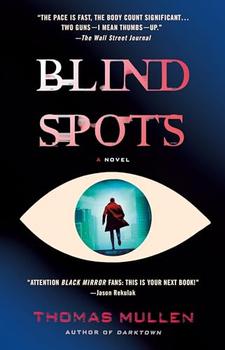Summary | Excerpt | Reading Guide | Reviews | Beyond the book | Read-Alikes | Genres & Themes | Author Bio

Critics' Opinion:
Readers' Opinion:
First Published:
Aug 2020, 352 pages
Paperback:
Aug 2021, 352 pages
 Book Reviewed by:
Book Reviewed by:
Norah Piehl
Buy This Book
I'm not much of a science fiction reader, though frequently when I do pick up a science fiction novel or story, I appreciate the ways in which authors who excel in this genre use their fiction to comment on contemporary or universal themes, even in the context of futuristic or alien settings. Carole Stivers' debut novel, The Mother Code, certainly falls into this category, and its relevance to our current historical moment has only grown between the time of its writing and its publication.
As the novel opens in the year 2049, a group of U.S. scientists is beginning to come to terms with a chilling reality. A DNA-based, nanosized bioweapon, developed by the CIA and known as IC-NAN, was designed to infect its human targets with a terminal lung disease–like ailment. IC-NAN was intended to die out if it didn't find a human host, but it has instead found a receptive home in desert archaebacteria (see Beyond the Book). Now there's no way to stop the subsequent spread. Without a permanent cure (the scientists have an antidote that slows IC-NAN's effects but doesn't halt them entirely), the human species will be annihilated.
Or at least the current generations of the human species. One potential avenue toward species survival is to manipulate the genes of human fetuses to make them immune to IC-NAN. However, given the rapid global spread, by the time they develop this technology, no human mother would live long enough to carry a baby to term or to raise her child. To address this problem, scientists apply existing research on coding computers to perform maternal behaviors. Rose McBride, the primary scientist working on the project — called the Mother Code — is daunted by the unimaginably high stakes of her new work: "She was dogged by fear—fear that if it ever had to be used, her Mother Code would fail the ones who needed it, defenseless children in a new world." But despite this fear, in a grand and generous experiment, Rose and her collaborators quickly develop an army of robotic mothers, designed to incubate their genetically engineered babies and to raise them in isolation until they are signaled that it's safe to reintroduce them to human society, i.e., one another.
The novel's first section, which opens with this horrifying realization and continues to the launch of the Mother Code project a couple of years later, unfolds rapidly and with incredible suspense, as the narrative shifts back and forth between the various scientists and military personnel addressing this crisis months or years before the general public even realizes what's going on. This section is bold and cinematic, introducing a half-dozen compelling characters doing their best to stay focused and sane despite the apocalyptic future staring them in the face, and various subplots (including romance). And, as readers come to know these doomed adults, Stivers also introduces them to Kai, one of the genetically-engineered babies, whom we see in the future with his robotic mother Rosie (or Rho-Z), their story providing reassurance about the scientists' success without detracting from the suspense of their desperately urgent mission.
After this adrenaline rush of an opening section with its frequent geographic and chronological shifts, the novel's second section settles into a single narrative about a decade later, as the genetically modified children who will be the future of the planet are approaching 10 years old. The robotic mothers' programming has begun allowing their children to interact with one another, though their children's growing desire for independence is soon at odds with the mothers' protective instincts (or, rather, coding). The struggles between freedom and safety familiar to parents and children everywhere play out at incredibly high stakes for the future of humanity against a backdrop of the arid landscapes of the western U.S.
Stivers is a biochemist by training, and consequently The Mother Code doesn't hold back when it comes to introducing and explaining fairly complicated scientific topics. Fortunately (for this science fiction novice at least!), the science behind the story is explained clearly and compellingly, and integrated logically into the novel's structure without disrupting its breakneck pacing. But Stivers' novel is not merely a book-length thought experiment about the consequences of a scenario like the one she envisions. It also carries immense and poignant resonance about the vitality and fragility of human lives and relationships and the complexity of human emotional needs, offering heartbreaking scenes of both optimism and grief.
Despite its apocalyptic premise, The Mother Code is, at its heart, a surprisingly hopeful novel, one that offers a particularly generous depiction of scientists using their skills and training to address a future that they know they will never see. In that way, beyond its more obvious themes about parental traits and whether they could be isolated and programmed, the novel could be read as an allegory about other real-life visions of an uncertain future — a celebration of those who, like present-day climate scientists, are doing their best to ensure humanity's survival despite the odds. Stivers portrays scientific inquiry and technological development as our greatest hope, and its practitioners as both brilliant and compassionate caretakers of the future of humankind.
![]() This review was originally published in The BookBrowse Review in September 2020, and has been updated for the
September 2021 edition.
Click here to go to this issue.
This review was originally published in The BookBrowse Review in September 2020, and has been updated for the
September 2021 edition.
Click here to go to this issue.

If you liked The Mother Code, try these:

by Ben H. Winters
Published 2024
In this "wild and wonderful" (Lou Berney) corporate espionage thriller that takes the adage "time is money" and makes it frighteningly so, an everywoman FDA employee stumbles upon a dark, clandestine conspiracy to harvest and sell people's time.

by Thomas Mullen
Published 2024
A riveting crime novel with a speculative edge about the ways our perceptions of reality can be manipulated.





The House on Biscayne Bay
by Chanel Cleeton
As death stalks a gothic mansion in Miami, the lives of two women intertwine as the past and present collide.

The Flower Sisters
by Michelle Collins Anderson
From the new Fannie Flagg of the Ozarks, a richly-woven story of family, forgiveness, and reinvention.

The Funeral Cryer by Wenyan Lu
Debut novelist Wenyan Lu brings us this witty yet profound story about one woman's midlife reawakening in contemporary rural China.
Your guide toexceptional books
BookBrowse seeks out and recommends the best in contemporary fiction and nonfiction—books that not only engage and entertain but also deepen our understanding of ourselves and the world around us.